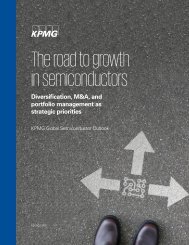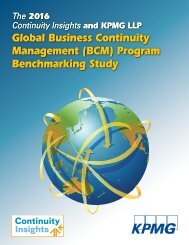Revenue for Telecoms
2cdncba
2cdncba
You also want an ePaper? Increase the reach of your titles
YUMPU automatically turns print PDFs into web optimized ePapers that Google loves.
<strong>Revenue</strong> <strong>for</strong> <strong>Telecoms</strong> – Issues In-Depth | 17<br />
1.4 Portfolio approach |<br />
Alternative revenue programs <strong>for</strong> regulated telecom services<br />
980-605-25-1 – 25-4, 606-10-50-4a As mentioned above, in some jurisdictions, telecom services are subject to rate<br />
regulation. Current US GAAP requirements on the recognition of regulatory<br />
assets and liabilities from alternative revenue programs are outside the scope<br />
of the new standard. However, the new standard requires revenue arising from<br />
regulatory assets and liabilities to be presented separately from revenue arising<br />
from contracts with customers in the statement of comprehensive income.<br />
The new standard only applies to the operations of rate-regulated entities <strong>for</strong><br />
ordinary activities that are not subject to rate regulation. Entities will continue<br />
to follow current US GAAP requirements to account <strong>for</strong> alternative revenue<br />
programs, because these contracts are considered to be contracts with a<br />
regulator and not with a customer. This may result in a difference <strong>for</strong> rateregulated<br />
entities with similar alternative revenue programs if they apply IFRS but<br />
are not eligible to apply the interim standard on regulatory deferral accounts.<br />
1.4 Portfolio approach<br />
Requirements of the new standard<br />
606-10-10-4<br />
[IFRS 15.4]<br />
The new standard is generally applied to an individual contract with a customer.<br />
However, as a practical expedient, an entity may apply the revenue model to a<br />
portfolio of contracts with similar characteristics if the entity reasonably expects<br />
that the financial statement effects of applying the new standard to the individual<br />
contracts within that portfolio would not differ materially.<br />
Example 5 – Portfolio approach applied to costs<br />
In April 20X8, Cable A store sold 100 television cable contracts. The store employs<br />
several sales agents who will receive a bonus of 10 <strong>for</strong> each contract they obtain.<br />
Cable A determines that each bonus constitutes a cost of obtaining a contract<br />
(see 7.1) and should be capitalized and amortized over the life of that underlying<br />
contract and any anticipated renewal that the bonus benefits (see 7.3).<br />
Cable A determines that the portfolio approach is appropriate because the costs<br />
are all related to obtaining a contract and the characteristics of the contracts<br />
are similar. The amortization period <strong>for</strong> the asset recognized related to these<br />
costs is expected to be similar <strong>for</strong> the 100 contracts (see 7.3). Additionally, Cable<br />
A documents that the portfolio approach does not materially differ from the<br />
contract-by-contract approach. Instead of recording and monitoring 100 assets of<br />
10 each, Cable A records a portfolio asset of 1,000 <strong>for</strong> the month of April 20X8.<br />
© 2016 KPMG LLP, a Delaware limited liability partnership and the US member firm of the KPMG network of<br />
independent member firms affiliated with KPMG International Cooperative, a Swiss entity. All rights reserved.<br />
© 2016 KPMG IFRG Limited, a UK company, limited by guarantee. All rights reserved.<br />
Home







